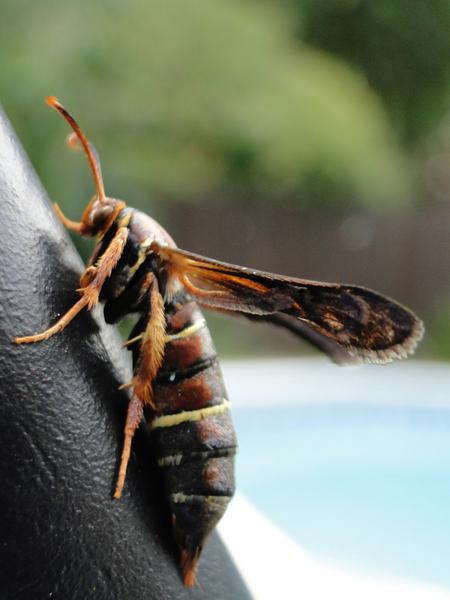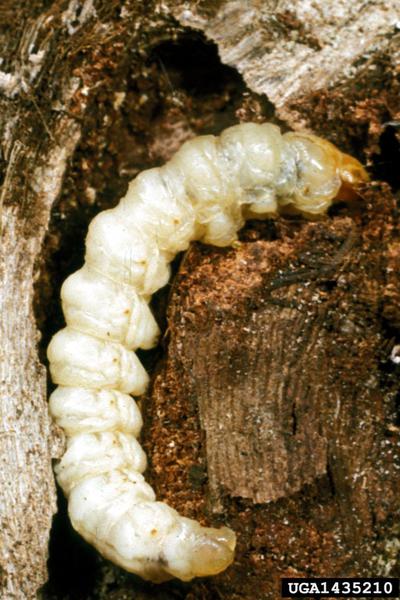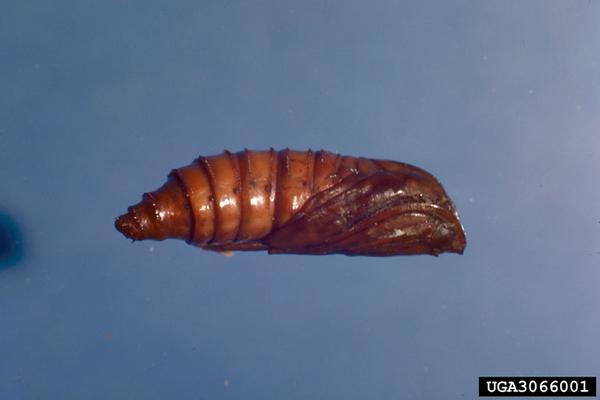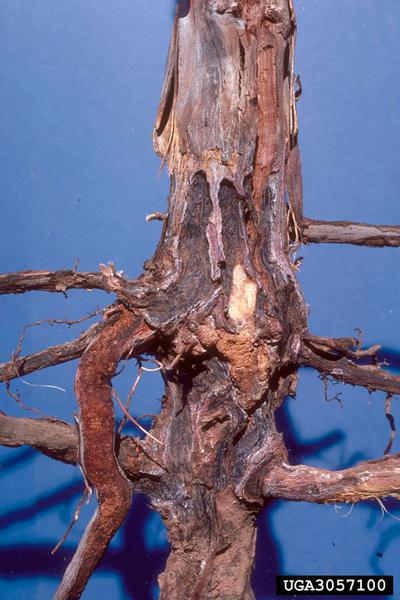Biology
The grape root borer (Vitacea polistiformis) is a caterpillar that feeds on the roots of grape plants. Adults look similar to paper wasps, but are actually clear-wing moths. In North Carolina, the moths emerge in July to through September. After emerging, females will lay eggs on the undersides of grape leaves near the bottom of the grape plant. The newly hatched larvae drop into the soil near the base of the vines and begin to feed on the roots, eventually tunneling into the roots. In North Carolina, larvae take one to two years to mature, depending on temperature. Fully grown larvae are white with light-brown heads and about two inches long. Mature larvae pupate a few inches under the surface of the soil, and a new generation of moths emerge from the pupae to start the cycle again. Both cultivated and wild grapes are hosts of the grape vine borer.
Damage in Grapes
Larvae tunnel into the grape roots and feed on the root core. Damage by the grape root borer weakens and can eventually kill grape vines. Successive feeding by more than one generation of grape root borers is typically necessary to damage plants, and vines begin to decline two to five years after infestation begins. Roots fed upon by mature larvae will have the central portion of the root chewed out and filled with reddish colored frass (insect droppings). All grapes types, including muscidine, labrusca, and vinifera, can be damaged by grape root borers.
Sampling and Thresholds
No defined economic thresholds exist for grape root borers in North Carolina. Growers can sample several ways for grape root borers. Sampling is important to determine if and when management efforts are needed.
Pheromone Bucket Traps
The easiest and most common form of sampling for grape root borers is with pheromone-baited bucket traps. Bucket traps consist of a lidded container with a pheromone lure over a hole in the lid and insecticidal strips inside the bucket. Male moths are attracted to the pheromone, get stuck in the container, and are killed by the insecticidal strips. In North Carolina, traps should be placed in late June and checked weekly for moths until the beginning of September. Current recommendations are to place at least one trap per variety block within a vineyard. .
Pheromone traps are a good way of keeping track of changes in the overall moth population in and around a vineyard. However, since they attract moths over a long distance, pheromone traps cannot be used to determine the exact number of moths in a smaller block of the vineyard.
Pupal Sampling
Pupal sampling is visually counting the moth pupal casings protruding out of the soil. Pupal sampling provides a more accurate count of grape vine borers present in a vineyard, but is more labor intensive than pheromone trapping. Pupal sampling is recommended if growers need to determine the relative number of pupae between different varieties or blocks in a vineyard, or have another reason to need precise insect counts. Vineyards with bare soil around the base of the vines are much easier to spot pupae in than ones with vegetation cover.
In North Carolina, pupal sampling should be done weekly from late June to the end of August.
Root damage sampling
Digging up vines to look for larval damage is impractical for large scale monitoring. However, if vines are already being removed and vine borers are suspected, roots can be cut open and inspected for areas filled with reddish frass.
Management Options
Mating Disruption
Mating disruption relies on the placement of a large number of pheromone-laced twist ties in the vineyard. These pheromones interfere with the ability of male moths to find and mate with females, and thereby can dramatically decrease the number of new larvae in a vineyard. North Carolina growers have reported 100% reductions in trap captures in muscadine grapes after mating disruption, and experiments in Virginia have reported 90% reduction in bunch grapes.
Isomate GRB is currently the only commercially-available mating disruption product for grape root borer. 100 twist ties should be put out per acre. Ties should be placed before grape root borer emergence is expected, no later than the first week of July. Twist ties are effective for one field season and should be removed the following year to avoid worker confusion when placing new ties. For this reason, we recommend placing twist ties on canes that will be pruned out during the winter.
Conventional Insecticides
Refer to the North Carolina Agricultural Chemicals Manual for the most current recommendations on materials for grape root borer. Pesticide toxicity information for honeybees is also available in the North Carolina Agricultural Chemicals Manual.
The only conventional insecticide registered for use against grape root borer is chlorpyrifos (Lorsban 4E). This material should be applied to the soil at the base of the plant. For greatest efficacy, the soil around the base of the vines should be clear of weeds and other vegetation. Care should be taken to avoid spraying the foliage and fruit of the plants, and applications should be at least 35 days before harvest. Applications should be timed to correspond with the beginning of moth trap captures.
Organic Insecticides
There are no organically-acceptable insecticides that are effective against the grape vine borer.
Biological Control
Beneficial Heterorhabditis nematodes have been shown to reduce grape root borers in other parts of the country. However, these nematodes have not been compared in research trials in North Carolina. Nematode efficacy in other cropping systems is often sporadic, and dependent on favorable weather and proper application timing.
Cultural Control
Historically, root borers were managed by mounding soil near the base of the vines to prevent larvae from reaching the roots and to make it difficult for moths to emerge from the soil. This practice consists of creating 1-ft high, 1.5-ft wide soil mounds on both sides of the base of the vines when moths begin to emerge. Mounded soil must be removed again in September for bunch grapes and November or December for muscadine grapes to prevent rooting. This method is impractical for vineyards with vegetation between the rows and can cause erosion on hilly sites.
As an alternative, tightly sealed plastic mulch or landscape fabric can be used to cover the ground 3 feet on either side of the vines, but this barrier is only effective as long as it is in place and undamaged.
More Information
The Southern Region Small Fruit Consortium Bunch Grape IPM Guide and Muscadine IPM Guide contain regional recommendations for grape root borer management.
Publication date: April 16, 2020
Recommendations for the use of agricultural chemicals are included in this publication as a convenience to the reader. The use of brand names and any mention or listing of commercial products or services in this publication does not imply endorsement by NC State University or N.C. A&T State University nor discrimination against similar products or services not mentioned. Individuals who use agricultural chemicals are responsible for ensuring that the intended use complies with current regulations and conforms to the product label. Be sure to obtain current information about usage regulations and examine a current product label before applying any chemical. For assistance, contact your local N.C. Cooperative Extension county center.
N.C. Cooperative Extension prohibits discrimination and harassment regardless of age, color, disability, family and marital status, gender identity, national origin, political beliefs, race, religion, sex (including pregnancy), sexual orientation and veteran status.






